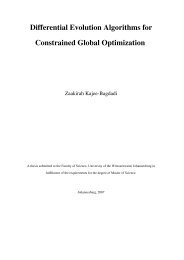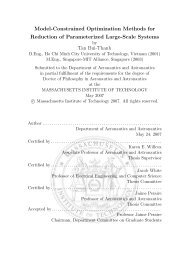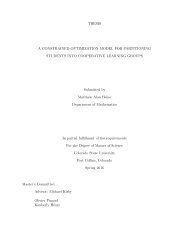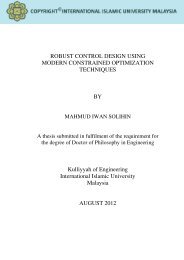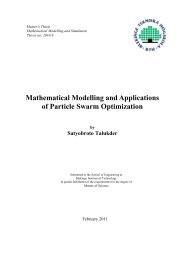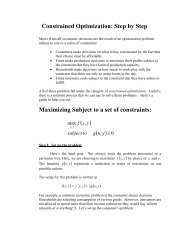Application of Genetic Algorithm in Multi-objective Optimization
You also want an ePaper? Increase the reach of your titles
YUMPU automatically turns print PDFs into web optimized ePapers that Google loves.
converge to a set <strong>of</strong> the solution as close as possible to the true Pareto-optimal set, which is the<br />
common <strong>objective</strong> <strong>of</strong> all optimization tasks. However, diversity <strong>in</strong> the obta<strong>in</strong>ed Pareto-optimal set is<br />
the second <strong>objective</strong> specific to multi-<strong>objective</strong> problems. With a more diverse set <strong>of</strong> solutions that<br />
covers all parts <strong>of</strong> the Pareto-front <strong>in</strong> the <strong>objective</strong> space, the decision-mak<strong>in</strong>g process at the next<br />
level us<strong>in</strong>g the higher level <strong>in</strong>formation is easier. S<strong>in</strong>ce two spaces are <strong>in</strong>volved <strong>in</strong> MOOP, diversity<br />
<strong>of</strong> solutions <strong>in</strong> both decision and <strong>objective</strong> space is def<strong>in</strong>ed. Solutions with a large Euclidean<br />
distance <strong>in</strong> variable and <strong>objective</strong> space are referred to as a diverse set <strong>of</strong> solutions <strong>in</strong> variable and<br />
<strong>objective</strong> space, respectively. The diversity <strong>in</strong> the two spaces is <strong>of</strong>ten Symmetric, however <strong>in</strong><br />
complex and non-l<strong>in</strong>ear problems this property may not be true. Hence, Deb [1] assumes that there<br />
are two goals <strong>in</strong> multi-<strong>objective</strong> optimization:<br />
a. To f<strong>in</strong>d a set <strong>of</strong> non-dom<strong>in</strong>ated solutions with the least distance to the Pareto-optimal set.<br />
b. To have maximum diversity <strong>in</strong> the non-dom<strong>in</strong>ated set <strong>of</strong> solutions.<br />
2.2.4 Classification <strong>of</strong> <strong>Multi</strong>-Objective <strong>Optimization</strong> <strong>Algorithm</strong> (MOOA):<br />
In section 2.1.1 it was mentioned that optimization solv<strong>in</strong>g methods are classified <strong>in</strong>to the classical<br />
and the evolutionary methods. That classification is also valid for multi-<strong>objective</strong> optimization<br />
problems.<br />
2.2.4.1 Classical Method for MOOA:<br />
In the classical method, <strong>objective</strong>s are transformed <strong>in</strong>to one <strong>objective</strong> function us<strong>in</strong>g different<br />
techniques. The classical methods for MOOA will not be discussed <strong>in</strong> detail as this research work is<br />
based on the EAs.<br />
2.2.4.2 Evolutionary <strong>Algorithm</strong>s (EAs) for MOOA:<br />
The characteristic <strong>of</strong> EAs <strong>of</strong> us<strong>in</strong>g a population <strong>of</strong> solutions that evolve <strong>in</strong> each generation is well<br />
suited for multi-<strong>objective</strong> optimization problems. S<strong>in</strong>ce one <strong>of</strong> the ma<strong>in</strong> goals <strong>of</strong> MOOP solvers is<br />
28



